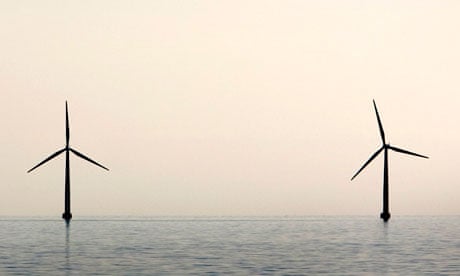Thirty kilometres off the west coast of Denmark, near the port of Esbjerg, the 91 turbines of the Horns Rev 2 wind farm turn night and day, by fair wind or foul. A total production capacity of 209 MW has been deployed since September 2009 over an area of almost 35 sq km.
Nearer to the coast the Horns Rev 1 farm, established in 2002, consists of 80 turbines rated at 160 MW. Together the two groups of machines make up the world's largest offshore wind farm. They are also the most recent example of Denmark's policy of promoting renewable energies.
In France the tumultuous adoption of the Grenelle-2 bill has ushered in a period of uncertainty for wind power, but the Danes are showing off the positive results of concerted development over the last 30 years, rooted in a mixture of political determination, streamlined administrative procedures and co-operation with local communities.
Wind farms, on land or sea, account for more than one-fifth of the electricity generated in Denmark, compared with 1.5% in France. To achieve this the Danes have used several forms of leverage. First, people tend to see wind as "everyone's business" to a greater extent than in other countries. "The drive to build wind farms started as a grassroots movement," says Ann Pedersen Bouisset, at the foreign ministry. "The first small masts were set up by co-operatives formed by communities or local councils."
This participatory approach is apparent too in the agreement on energy policy between the government and most political parties, setting forth national strategy until 2011. The deal allows the general public to purchase shares in wind farms being built near to their homes. It also provides subsidies to help the local owners of turbines fund preliminary appraisals of future projects.
By guaranteeing the community a say in the planning process, this method has contributed to wind farms' social acceptability. Nine out of 10 Danes cite wind power as the main priority for developing renewable energies, according to a recent survey.
The fishing community was also involved well before work started. The Esbjerg fleet is not against the project, convinced that it was better to have some say in the final outcome rather than attempting to stop it, probably in vain. The fishermen succeeding in getting the farm moved away from fishing zones and negotiated $1.3m in compensation.
Another factor in the success of Danish projects is that project management has been streamlined. The Danish Energy Authority set up a single body, representing the various ministries involved and Energinet, the national grid operator. This body takes charge of selecting locations, co-ordinating the research and issuing calls for tenders. Energinet is under obligation to connect any project authorised by this process and must pay a penalty for any delay once electricity production has started.
Wind power has had a noticeable impact on Danish industry. In 2010 sales of wind technology are slated to represent more than a tenth of all exports. Boosted by the Horns Rev schemes, which have picked up where offshore oil drilling left off, the port at Esbjerg now ranks as "the country's top logistics platform for offshore facilities", says John Snedker, a local councillor.
The Danish firm Vestas, based in Esbjerg, sells turbines all over the world. Siemens Wind Power, a German firm, has a factory there and is exporting local equipment for installation off the British coast.
France is still preparing to take the plunge, whereas Denmark is already thinking about upgrading its ageing farms and has launched a modernisation programme backed by government subsidies. Meanwhile, Danish firms are banking on increasingly large farms and powerful turbines.
This article originally appeared in Le Monde
